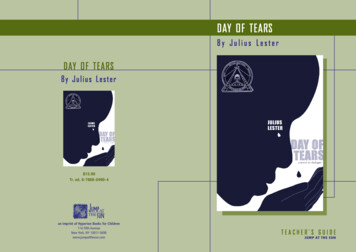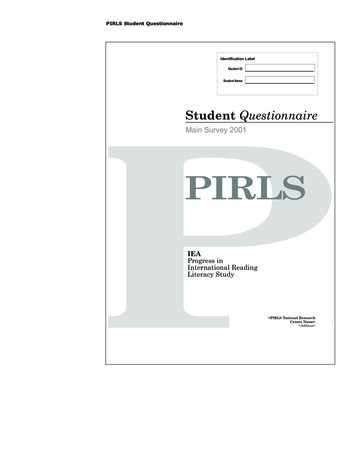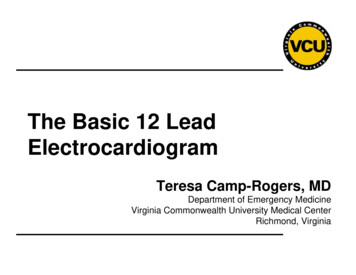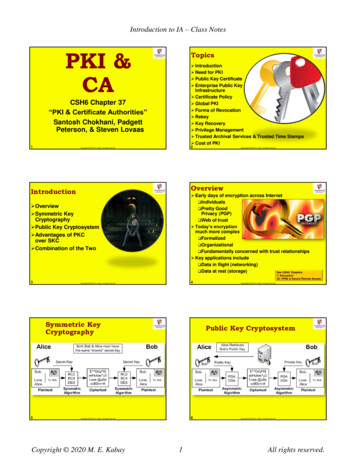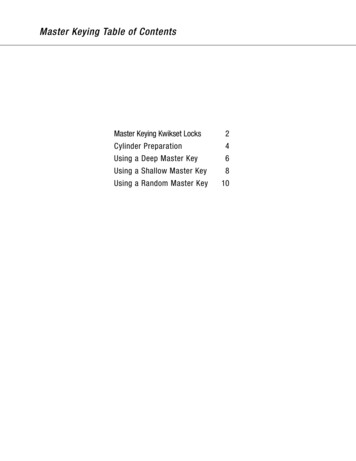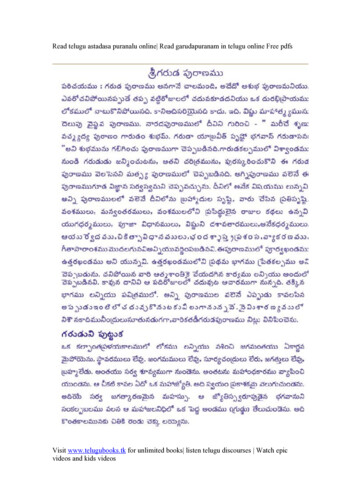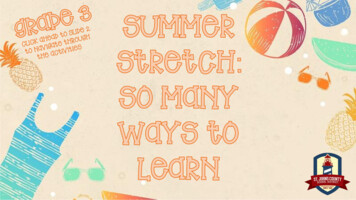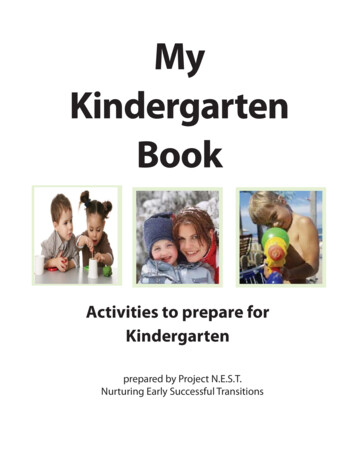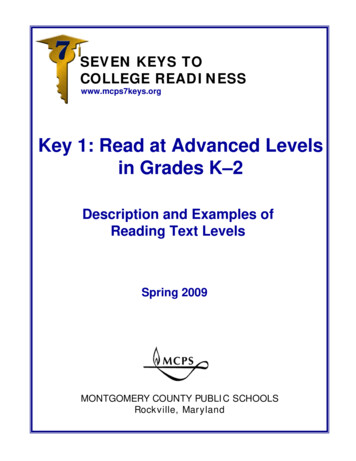
Transcription
SEVEN KEYS TOCOLLEGE READINESSwww.mcps7keys.orgKey 1: Read at Advanced Levelsin Grades K–2Description and Examples ofReading Text LevelsSpring 2009MONTGOMERY COUNTY PUBLIC SCHOOLSRockville, Maryland
Table of ContentsElementary Reading Text Level Description .page 1Literary Text Level 4 .page 2Informational Text Level 4 .page 3Literary Text Level 6 .page 4Informational Text Level 6 .page 5Literary Text Level 16 page 6Informational Text Level 16 .page 7Literary Text Level M .page 8Informational Text Level M page 9TerraNova, The Second Edition (TN2) Example page 10Teaching reading to young children is a complex process. Young children develop reading skillsand strategies at different rates and reach benchmarks at different times. This document providesexamples and characteristics of texts at levels 4, 6, 16 and M. Text levels are used to plan anddeliver reading instruction. Provide feedback on this document to the Department of Curriculumand Instruction, Elementary Reading Language Arts Department, 850 Hungerford Drive,Rockville, Maryland, 20850, Room 256, or at 301-279-3154.
Elementary Reading Text Level DescriptionLeveled texts are an arrangement of books, both literary and informational, from easiest tohardest defined by a set of characteristics. Literary texts are stories, poems, and plays.Informational texts convey or explain. Assigning levels to texts assists teachers in selectingbooks that match readers’ skills to the supports and challenges in the text.Text characteristics determine whether a text is easy or hard for a student to read. There is adegree of variation within each level. The challenge of one book might be figurative language,while the challenge of another book at the same level might be sentence length, vocabulary, oradvanced concepts.In MCPS, two leveling systems are used: Reading Recovery Text Levels 1–16 Guided Reading (Fountas and Pinnell) Text Levels J ZThe Reading Recovery numerical system is used to designate kindergarten and first gradelevel-appropriate text in all MCPS schools and aligns with Reading Recovery. ReadingRecovery is a first grade intervention that is implemented in selected elementary schools. Thetransition to the Guided Reading alphabetical system occurs at the second grade level.Text levels indicate a progression from easiest to most challenging and are not limited to aspecific grade level. However, to provide guidance to teachers, a Reading Targets Text LevelChart has been developed.Reading Targets Text Level Chart: K–5GradeLevelEnd ofFirst QuarterEnd ofSecond QuarterEnd ofThird QuarterEnd ofFourth QuarterKindergarten(NotApplicable)Level 1 (A)Level 2–3(B–C)Level 4 (C)*First GradeLevel 5–7(D–E)Level 8–11(E–G)Level 12–15(H–I)Level 16–17(I)Second GradeLevel JLevel KLevel LLevel MThird GradeLevel MLevel NLevel OLevel PFourth GradeLevel Q–RLevel S–TFifth GradeLevel T–ULevel V–W* Text level 6 has been identified as the stretch goal for the end of kindergarten, in accordance with the7 Keys to College Readiness Advanced Reading in Grades K–2.Office of Curriculum and Instructional Programs, 2009-1-
Text Level 4—Literary TextSample text from Little Chimp and Big Chimp. The Book Has simple three- and four-word sentences.many familiar words repeatedthroughout the book.some words with inflectional endings(-s, -ed, -ing).pictures that help tell the story.Beginning level texts can be previewed at the school.Office of Curriculum and Instructional Programs, 2009-2- The Student Is Learning to read and write about 25 30 familiarwords.think about: Does it make sense? andDoes it sound right?use beginning consonant sounds toread unknown words.accurately read the words as if talking.retell the story in own words.
Text Level 4—Informational TextSample text from Up and Down. The Book Has simple three- and four-word sentences.many familiar words that are repeatedthroughout the book.some words with inflectional endings(-s, -ed, -ing).pictures that support the facts ininformational text.Beginning level texts can be previewed at the school.Office of Curriculum and Instructional Programs, 2009-3- The Student Is Learning to read and write about 25 30 familiarwords.think about: Does it make sense? andDoes it sound right?use beginning consonant sounds toread unknown words.accurately read the words as if talking.retell the facts in own words.
Text Level 6—Literary TextSample text from Clever Fox. The Book Has a variety of sentences with up to eightto ten words.many familiar words that students needto read quickly.words with basic phonetic patterns,such as consonants, digraphs, andshort vowel sounds.words with inflectional endings(-s, -ed, -ing).some compound words.some irregular past tense verbs (ran,came).pictures that support a storyline withreal problems and solutions in narrativetext or facts in informational text.Beginning level texts can be previewed at the school.Office of Curriculum and Instructional Programs, 2009-4- The Student Is Learning to read and write 40 or more familiarwords.use basic phonetic skills, such asconsonants, digraphs, and short vowelsounds to read unfamiliar words.think about, while reading: Does itmake sense? Does it sound right? andDoes it look right?reread to self-correct errors.read with fluency, expression, andphrasing.use punctuation to guide meaning andfluency.retell the story or facts in own words.answer questions about what is read.
Text Level 6—Informational TextSample text from How Machines Help. The Book Has a variety of sentences with up to eightto ten words.many familiar words that students needto read quickly.words with basic phonetic patterns,such as consonants, digraphs, andshort vowel sounds.words with inflectional endings(-s, -ed, -ing).some compound words.some irregular past tense verbs (ran,came).pictures that support facts ininformational text.additional features, such as labels, boldprint, headings, table of contents,index, and challenging concepts andvocabulary.Beginning level texts can be previewed at the school.Office of Curriculum and Instructional Programs, 2009-5- The Student Is Learning to read and write 40 or more familiarwords.use basic phonetic skills, such asconsonants, digraphs, and short vowelsounds to read unfamiliar words.think about, while reading: Does itmake sense? Does it sound right? andDoes it look right?reread to self-correct errors.read with fluency, expression, andphrasing.use punctuation to guide meaning andfluency.retell the story or facts in own words.answer questions about what is read.
Text Level 16—Literary TextSample text from The Tale of the Turnip. The Book Has longer simple sentences and longercompound sentences that may includeclauses and prepositional phrases.a wide range of familiar words.many multisyllable words, generallyeasy to take apart to decode.many words with endings (-s, -ed,-ing), plurals, contractions, compoundwords, and possessives.more detailed episodes.Familiar books—Level 16: Angus and the Cat, Marjorie Flack Are You My Mother?, P.D. Eastman A Color of His Own, Leo Lionni The Student Is Learning to self-monitor for meaning and sentencestructure.apply phonetic skills to unknown wordsby taking words apart as they read.self-correct errors more consistently.discuss what is stated directly and whatis implied in text.gain speed during reading and strengthfor longer periods of reading. Office of Curriculum and Instructional Programs, 2009-6-Henny Penny, Paul GoldoneLeo the Late Bloomer, Robert Kraus
Text level 16—Informational TextSample text from The Busy Beavers. The Book Has longer simple sentences and longercompound sentences that may includeclauses and prepositional phrases.a wide range of familiar words.many multisyllable words, generallyeasy to take apart to decode.many words with endings (-s, -ed,-ing), plurals, contractions, compoundwords, and possessives.more detailed episodes.abstract ideas and unfamiliar conceptswithin informational text.a variety of additional features, such aslabels, bold print, headings, glossary,insets, table of contents, index, andchallenging concepts and vocabulary.Familiar books—Level 16: Angus and the Cat, Marjorie Flack Are You My Mother?, P.D. Eastman A Color of His Own, Leo Lionni The Student Is Learning to self-monitor for meaning and sentencestructure.apply phonetic skills to unknown wordsby taking words apart as they readself-correct errors more consistently.discuss what is stated directly and whatis implied in text.gain speed during reading and strengthfor longer periods of reading. Office of Curriculum and Instructional Programs, 2009-7-Henny Penny, Paul GoldoneLeo the Late Bloomer, Robert Kraus
Text Level M—Literary TextSample text from The One in the Middle is the Green Kangaroo. The Book Has sentences of varying length, with somevery long complex sentencescontaining introductory clauses, andnouns, verbs, or adjectives in a series.unfamiliar content supported orextended by illustrations.simple plots and may include chapterswith multiple episodes.more challenging vocabulary. Familiar books—Level M: A Picture Book of Thurgood Marshall,David Adler Sharks, Gail Gibbons Blueberries for Sal, Robert McCloskeyThe Student Is Learning to think about what he/she already knowsabout the topic or subject, preview thetext before reading, and makepredictions.self-monitor for meaning.apply strategies when meetingchallenges while reading.demonstrate literal, inferential, andcritical comprehension orally and inwriting after reading.read longer text silently andindependently. Office of Curriculum and Instructional Programs, 2009-8-A Chair for My Mother, Vera WilliamsJunie B. Jones, Barbara Park
Text Level M—Informational TextSample text from Seasons and Weather. The Book Has sentences of varying length, with somevery long complex sentencescontaining introductory clauses, andnouns, verbs, or adjectives in a series.unfamiliar content supported orextended by illustrations.a variety of layouts in informational text(question/answer, paragraphs, boxes,legends).a combination of graphics providinginformation that matches and extendsthe text, such as captions that provideimportant information to supplementthe body of the text.more challenging vocabulary.Familiar books—Level M: A Picture Book of Thurgood Marshall,David Adler Sharks, Gail Gibbons Blueberries for Sal, Robert McCloskey The Student Is Learning to think about what he/she already knowsabout the topic or subject, preview thetext before reading, and makepredictions.self-monitor for meaning.apply strategies when meetingchallenges while reading.demonstrate literal, inferential, andcritical comprehension orally and inwriting after reading.read longer text silently andindependently. Office of Curriculum and Instructional Programs, 2009-9-A Chair for My Mother, Vera WilliamsJunie B. Jones, Barbara Par
TerraNova, The Second Edition (TN2) ExampleThe TN2 is a standardized nationally normed assessment given to second gradestudents in the spring of each school year. The assessment tests knowledge and skillsin reading and mathematics. In the reading item below, students read the poem, MyFavorite Snow, and then respond to several multiple choice questions. A sample of amultiple choice question is provided below.Office of Curriculum and Instructional Programs, 2009- 10 -
Leveled texts are an arrangement of books, both literary and informational, from easiest to hardest defined by a set of characteristics. Literary texts are stories, poems, and plays. Informational texts convey or explain. Assigning levels to texts assists teachers in selecting


